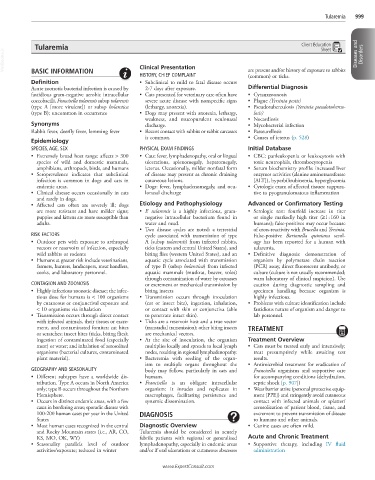Page 1996 - Cote clinical veterinary advisor dogs and cats 4th
P. 1996
Tularemia 999
Tularemia Client Education
Sheet
VetBooks.ir Clinical Presentation Diseases and Disorders
BASIC INFORMATION
HISTORY, CHIEF COMPLAINT are present and/or history of exposure to rabbits
(common) or ticks.
Definition • Subclinical to mild to fatal disease occurs
Acute zoonotic bacterial infection is caused by 2-7 days after exposure. Differential Diagnosis
fastidious gram-negative aerobic intracellular • Cats presented for veterinary care often have • Cytauxzoonosis
coccobacilli, Francisella tularensis subsp tularensis severe acute disease with nonspecific signs • Plague (Yersinia pestis)
(type A [more virulent]) or subsp holarctica (lethargy, anorexia). • Pseudotuberculosis (Yersinia pseudotubercu-
(type B); uncommon in occurrence • Dogs may present with anorexia, lethargy, losis)
weakness, and mucopurulent oculonasal • Nocardiosis
Synonyms discharge. • Mycobacterial infection
Rabbit fever, deerfly fever, lemming fever • Recent contact with rabbits or rabbit carcasses • Pasteurellosis
is common. • Causes of icterus (p. 528)
Epidemiology
SPECIES, AGE, SEX PHYSICAL EXAM FINDINGS Initial Database
• Extremely broad host range: affects > 300 • Cats: fever, lymphadenopathy, oral or lingual • CBC: panleukopenia or leukocytosis with
species of wild and domestic mammals, ulcerations, splenomegaly, hepatomegaly, toxic neutrophils, thrombocytopenia
amphibians, arthropods, birds, and humans icterus. Occasionally, milder nonfatal form • Serum biochemistry profile: increased liver
• Seroprevalence indicates that subclinical of disease may present as chronic draining enzymes activities (alanine aminotransferase
infection is common in dogs and cats in cutaneous lesions. [ALT]), hyperbilirubinemia, hyperglycemia
endemic areas. • Dogs: fever, lymphadenomegaly, and ocu- • Cytologic exam of affected tissues: suppura-
• Clinical disease occurs occasionally in cats lonasal discharge tive to pyogranulomatous inflammation
and rarely in dogs.
• Affected cats often are severely ill; dogs Etiology and Pathophysiology Advanced or Confirmatory Testing
are more resistant and have milder signs; • F. tularensis is a highly infectious, gram- • Serologic test: fourfold increase in titer
puppies and kittens are more susceptible than negative intracellular bacterium found in or single markedly high titer (≥1 : 160 in
adults. water and mud. humans); false-positives may occur because
• Two disease cycles are noted: a terrestrial of cross-reactivity with Brucella and Yersinia.
RISK FACTORS cycle associated with transmission of type False-positive Bartonella quintana serol-
• Outdoor pets with exposure to arthropod A (subsp tularensis) from infected rabbits, ogy has been reported for a human with
vectors or reservoirs of infection, especially ticks (eastern and central United States), and tularemia.
wild rabbits or rodents biting flies (western United States), and an • Definitive diagnosis: demonstration of
• Humans at greater risk include veterinarians, aquatic cycle associated with transmission organism by polymerase chain reaction
farmers, hunters, landscapers, meat handlers, of type B (subsp holarctica) from infected (PCR) assay, direct fluorescent antibody, or
cooks, and laboratory personnel. aquatic mammals (muskrat, beaver, voles) culture (culture is not usually recommended;
through contamination of water by carcasses warn laboratory of clinical suspicion). Use
CONTAGION AND ZOONOSIS or excrement or mechanical transmission by caution during diagnostic sampling and
• Highly infectious zoonotic disease; the infec- biting insects specimen handling because organism is
tious dose for humans is < 100 organisms • Transmission occurs through inoculation highly infectious.
by cutaneous or conjunctival exposure and (cat or insect bite), ingestion, inhalation, • Problems with culture identification include
< 10 organisms via inhalation or contact with skin or conjunctiva (able fastidious nature of organism and danger to
• Transmission occurs through direct contact to penetrate intact skin). lab personnel.
with infected animals, their tissues or excre- • Ticks are a reservoir host and a true vector
ment, and contaminated fomites; cat bites (transtadial transmission); other biting insects TREATMENT
or scratches; insect bites (ticks, biting flies); are mechanical vectors.
ingestion of contaminated food (especially • At the site of inoculation, the organism Treatment Overview
meat) or water; and inhalation of aerosolized multiplies locally and spreads to local lymph • Cats must be treated early and intensively;
organisms (bacterial cultures, contaminated nodes, resulting in regional lymphadenopathy. treat presumptively while awaiting test
plant material). • Bacteremia with seeding of the organ- results.
ism to multiple organs throughout the • Antimicrobial treatment for eradication of
GEOGRAPHY AND SEASONALITY body may follow, particularly in cats and Francisella organisms and supportive care
• Different subtypes have a worldwide dis- humans. for accompanying conditions (dehydration,
tribution. Type A occurs in North America • Francisella is an obligate intracellular septic shock [p. 907])
only; type B occurs throughout the Northern organism: it invades and replicates in • Wear barrier attire (personal protective equip-
Hemisphere. macrophages, facilitating persistence and ment [PPE]) and stringently avoid cutaneous
• Occurs in distinct endemic areas, with a few systemic dissemination. contact with infected animals or splatter/
cases in bordering areas; sporadic disease with aerosolization of patient blood, tissue, and
100-200 human cases per year in the United DIAGNOSIS excrement to prevent transmission of disease
States to humans and other animals.
• Most human cases recognized in the central Diagnostic Overview • Canine cases are often mild.
and Rocky Mountain states (i.e., AR, CO, Tularemia should be considered in acutely
KS, MO, OK, WY) febrile patients with regional or generalized Acute and Chronic Treatment
• Seasonality parallels level of outdoor lymphadenopathy, especially in endemic areas • Supportive therapy, including IV fluid
activities/exposure; reduced in winter and/or if oral ulcerations or cutaneous abscesses administration
www.ExpertConsult.com

